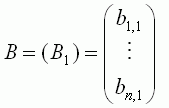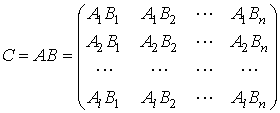| Equality of Matrices |
Two matrices of the same size, ![]() and
and ![]() , are equal if their corresponding
elements are equal, that is,
, are equal if their corresponding
elements are equal, that is,
|
for each pair of indexes {i,j} |
| Scalar Multiplication |
Any matrix A may be multiplied on the right
or left by a scalar ![]() . Then the product
. Then the product ![]() is the matrix
is the matrix ![]() of the same size as A
and such that
of the same size as A
and such that
![]()
for each pair of indexes {i, j}.
|
To multiply a matrix by a number, multiply every
element by the given number
|
| The Sum of Matrices |
The sum of any two ![]() matrices
matrices ![]() and
and ![]() is the
is the ![]() matrix
matrix ![]() such that
such that
![]()
for each pair of indexes {i, j}.
|
To add matrices, add the corresponding elements.
|
| Multiplication of a Row by a Column |
Let A be a row matrix having as many elements as a column matrix B. In order to multiply A by B, it is necessary to multiply the corresponding elements of the matrices and to add up the products. Symbolically,
 |
Thus, multiplying a row matrix by a column matrix we obtain a number. Later we will show that any number can be considered as an 1x1 matrix.
To multiply a two-row matrix

by the column matrix

we multiply each row of A by the column of B. In this case, the product AB is the following 2 x 1matrix:
 .
.
Similarly, the multiplication of an m-row matrix by a n-column matrix generate the m x n matrix.
| Matrix Multiplication |
Let A be a ![]() matrix and let B
be a
matrix and let B
be a ![]() matrix. Since A
has l rows and B
has n columns, the product C = AB
is the
matrix. Since A
has l rows and B
has n columns, the product C = AB
is the ![]() matrix. If we denote the rows of
A by
matrix. If we denote the rows of
A by ![]() and the columns of B
by
and the columns of B
by ![]() , then
, then
 ,
,
![]() ,
,
and

|
To find the element on the i-th row and the j-th column of the product C = AB, multiply the i-th row of A by the j-th column of B, that is, |
The matrix product AB is defined only if the number of columns of A is equal to the number of rows of B.
Note 1: The symbolic notation ![]() means the product of two equal square
matrices:
means the product of two equal square
matrices:
![]() .
.
Similarly,
![]() ,
,  .
.
Note 2: In the general case, the product of matrices is not commutative:
![]() .
.
